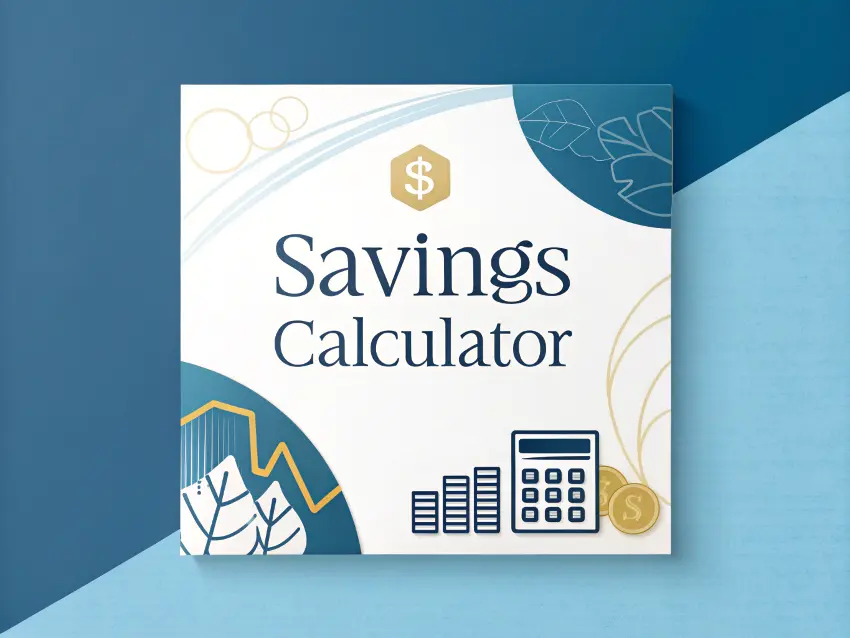Savings Calculator
Plan your savings goals, track progress, and calculate how your money will grow over time.

Savings Goals Planning
How Savings Grow:
Saving money effectively involves three key components: your initial deposit, regular contributions, and compound interest.
Compound Interest means that you earn interest not only on your initial investment but also on the interest that accumulates over time. This creates an accelerating growth effect.
Regular Deposits significantly enhance your savings growth. Even small, consistent contributions can lead to substantial results over time.
Compound Interest Formula:
FV = P(1 + r/n)^(nt) + PMT × [(1 + r/n)^(nt) - 1] / (r/n)
Where:
- FV = Future value of the investment
- P = Principal investment amount
- r = Annual interest rate (decimal)
- n = Number of times the interest is compounded per year
- t = Time in years
- PMT = Regular payment amount
Savings Tips
- Start early: Time is your most powerful ally in saving
- Automate savings: Set up automatic transfers to a savings account
- Pay yourself first: Make saving a priority in your budget
- Keep your money working: Look for accounts with competitive interest rates
- Review and adjust: Regularly review your savings progress and adjust as needed
Calculate Your Savings Growth
Savings Goal
$
$
Target date:
Regular Deposits
$
Interest Settings
%
Common savings account rates: 0.5% - 4%
%
Typical range: 2% - 4%
Savings Projection
Goal in Progress
Future Savings Balance:
$0.00
After 5 years
Inflation-Adjusted Value:
$0.00
In today's dollars
Total Deposits:
$0.00
Interest Earned:
$0.00
Monthly Deposit Needed to Reach Goal:
$0.00
Recommended monthly deposit to reach your target of $10,000.00 by
Savings Growth Over Time
Effective Savings Strategies
The 50/30/20 Budget Rule
This popular budgeting method suggests allocating your after-tax income as follows:
| Category | Percentage | Description |
|---|---|---|
| Needs | 50% | Essential expenses like housing, food, utilities, transportation |
| Wants | 30% | Non-essential expenses like dining out, entertainment, subscriptions |
| Savings | 20% | Savings, investments, debt payments beyond minimums |
Common Savings Goals
Emergency Fund
Aim for 3-6 months of essential expenses in an easily accessible account for unexpected events like medical emergencies or job loss.
Major Purchases
Save for specific goals like a home down payment, car, wedding, or vacation to avoid debt and reduce financial stress.
Retirement
Contributing to retirement accounts early and consistently helps ensure financial security in your later years through the power of compound interest.
Education
Whether for yourself or your children, dedicated education savings can reduce the need for student loans and provide more opportunities.
Savings Account Options
| Account Type | Typical Interest Rate | Best For |
|---|---|---|
| Traditional Savings | 0.01% - 0.10% | Easy access to funds with minimal growth |
| High-Yield Savings | 1.00% - 4.00% | Emergency funds, short-term goals |
| Certificate of Deposit (CD) | 1.00% - 5.00% | Known future expenses, no early access needed |
| Money Market | 1.00% - 3.00% | Balance between access and growth |
Tips for Consistent Saving
- Automate your savings: Set up automatic transfers to your savings account on paydays so you never "see" the money in your checking account.
- Use the "pay yourself first" strategy: Treat savings as a non-negotiable expense, like a bill payment, that happens before discretionary spending.
- Try the 30-day rule: For non-essential purchases, wait 30 days before buying. This helps avoid impulse purchases and builds savings.
- Track your progress: Regularly review your savings goals and celebrate milestones to stay motivated.
- Find extra income opportunities: Consider a side hustle, selling unused items, or freelance work to boost your savings rate.
- Use windfalls wisely: When you receive tax refunds, bonuses, or gifts, save at least a portion rather than spending it all.